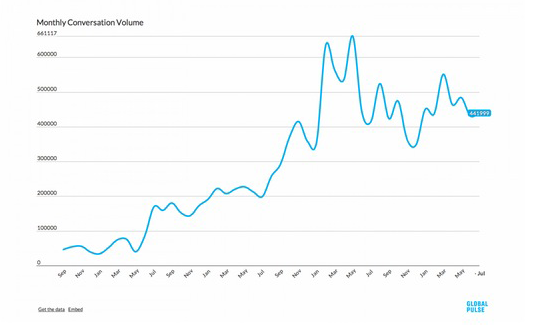Advocacy Monitoring Through Social Data: Women’s and Children’s Health
This post originally appeared on the UN Global Pulse website here. Reposted with permission.
Project Objectives
First of the short-term research projects resulting from Global Pulse’s recent call for research proposals, this analysis aimed at evaluating the impact of the Every Woman Every Child movement since is launch in 2010, as well as determining whether there has been any change in general public awareness of issues related to children’s and women’s (particular mothers) health reflected in Twitter conversations.
Project Partners
Every Woman Every Child, United Nations Foundation
Project Overview
Using Crimson Hexagon’s analytical tool Forsight, we were able to access and analyze an archive of all public tweets from September 2009 to July 2013. A taxonomy of relevant keywords was developed to identify messages related to women’s and children’s health (for instance, searching keywords such as “maternal health,” “breastfeeding,” “vaccination of children”). After searching the Twitter firehose for occurrence of the keywords, we trained a monitor to recognize relevant tweets. The resulting 14 million tweets about women’s and children’s health were then analyzed to identify spikes, trends and possible connections with real life events and campaigns.
Preliminary Findings
Close to 14 million tweets have been generated by the global public in the last 3 years related to the topics of children’s and women’s health.
The trend analysis showed that, in the period of investigation, there has been an increase in English tweets related to women’s and children’s health of 1000%. (An important caveat to note, however, is that this is largely attributable to greater numbers of people using the Twitter service over the past two years. The next phase of our analysis will adjust for “Twitter inflation.”) While content relevant to children’s health represent the majority of tweets throughout the period of investigation, the relative growth of the conversation about women’s health over the past 18 months has been exponential.
The study also shed some insight on who is engaged and paying attention to the issues, from a demographic perspective. While the majority of users talking about the women’s and children’s health are women, the percentage of men tweeting about these topics grew through the period analyzed, at times surpassing the 50%.
The volume of tweets reflected real life events and initiatives on topic days. Specifically, spikes in conversations were observed in occurrence of World Aids Day, Mothers Day, International Women’s Day and even at key moments such as the MDG summit and Women Deliver conferences, showing that advocacy efforts are working and the public mind-share and attention is being maintained on the issues.
Status
Ongoing.



